Before you start designing your Amazon Storefront, you need to get the basics right in Seller Central. Handling these first two steps correctly prevents major headaches later.
Your ability to build a custom, multi-page brand hub on Amazon depends on having two key elements in place: a Professional seller account and enrollment in Amazon Brand Registry.
Amazon Store Setup Essentials
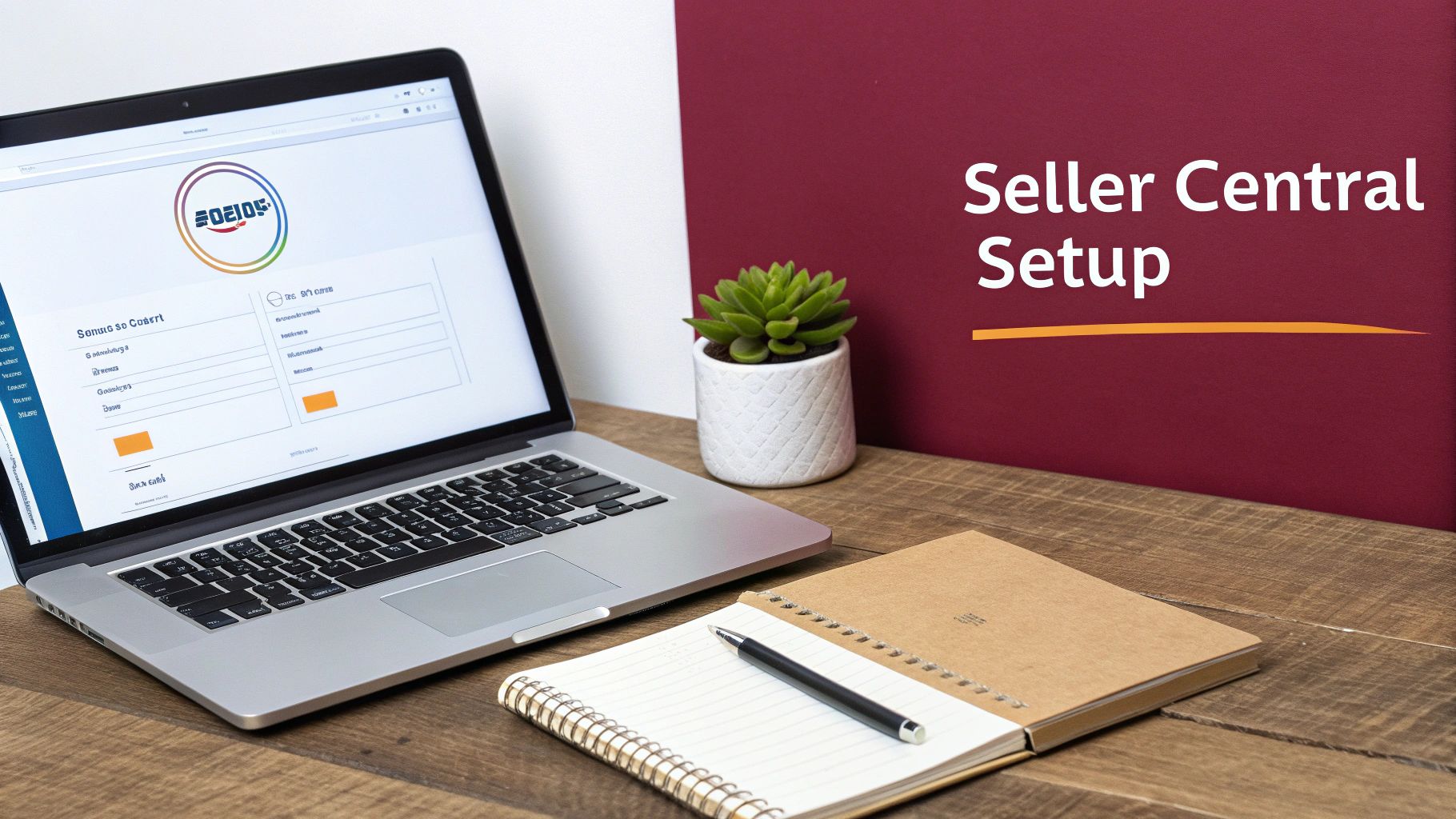
Think of this as laying the concrete for your house. Without a solid foundation, nothing else you build on top will last. Let’s walk through exactly what you need.
1. Seller Account Requirement
First things first: you can’t build a Storefront on an Individual seller plan. It’s just not an option. Access to the Stores builder tool is an exclusive feature for sellers on the Professional selling plan.
If you’re already on the Individual plan, you’ll need to upgrade. If you’re just starting and know a branded storefront is your goal, sign up for the Professional plan from day one to save yourself the hassle.
When you go through the seller account registration, have this info ready to make it go smoothly:
- Business Information: Your legal business name, address, and contact details.
- Credit Card: A valid credit card with international charging capabilities.
- Bank Account: An active bank account where Amazon can deposit your earnings.
- Tax ID: Your tax identification number, such as an SSN or EIN.
Having this information organized beforehand makes the seller account setup quick and painless.
To make it crystal clear, here’s a breakdown of why the Professional plan is a must-have for building a Storefront.
Professional vs. Individual Seller Plan for Storefronts
| Feature Access | Individual Seller Plan | Professional Selling Plan |
|---|---|---|
| Amazon Stores Builder Tool | ❌ No Access | ✅ Full Access |
| Amazon Brand Registry | ❌ Not Eligible | ✅ Eligible to Enroll |
| A+ Content Manager | ❌ No Access | ✅ Full Access |
| Monthly Subscription Fee | $0 (plus per-item fee) | Subscription Fee |
| Best For | Casual sellers with few items | Serious brands aiming to grow |
As you can see, the Individual plan is a non-starter if a branded presence is your goal. The Professional selling plan is the key that opens up all the essential brand-building tools on Amazon.
2. You Can’t Skip Amazon Brand Registry
The second critical piece is enrolling in Amazon Brand Registry. This is your golden ticket. It unlocks Storefronts, A+ Content, and a suite of tools designed for brand protection.
With 9.7 million registered sellers globally as of 2025 and 2.5 million actively making sales, the marketplace is crowded. Brand Registry is Amazon’s way of verifying you’re the real deal, helping protect your brand identity and giving you control over your product listings.
Think of it as your brand’s official passport on Amazon. For a deeper dive, check out our guide on the benefits of Amazon Brand Registry.
Brand Registry Enrollment Process
To get into Brand Registry, you need a registered trademark. This is a common hurdle for new sellers, but you have a few ways to tackle it.
- You Have a Registered Trademark: If you already have a registered word mark or design mark from an office like the USPTO, the brand enrollment process is simple. You’ll just submit your trademark registration number.
- You Have a Pending Trademark: Good news. Amazon now accepts brands with a pending trademark application from select trademark offices, which dramatically speeds up your timeline.
- You Don’t Have a Trademark: If you’re starting from scratch, Amazon’s IP Accelerator program is your best option. It connects you with trusted IP law firms to help file an application. The biggest advantage? Amazon grants you access to Brand Registry features while your trademark is pending, which can save you months.
Once Amazon completes the brand owner verification and you get the Brand Registry approval email, the “Stores” tab will appear in your Seller Central dashboard. That’s your green light to create an Amazon store. Getting this foundation right gives you the tools and intellectual property protection you need to build a powerful presence.
How to Create Amazon Store: Step-by-Step Process
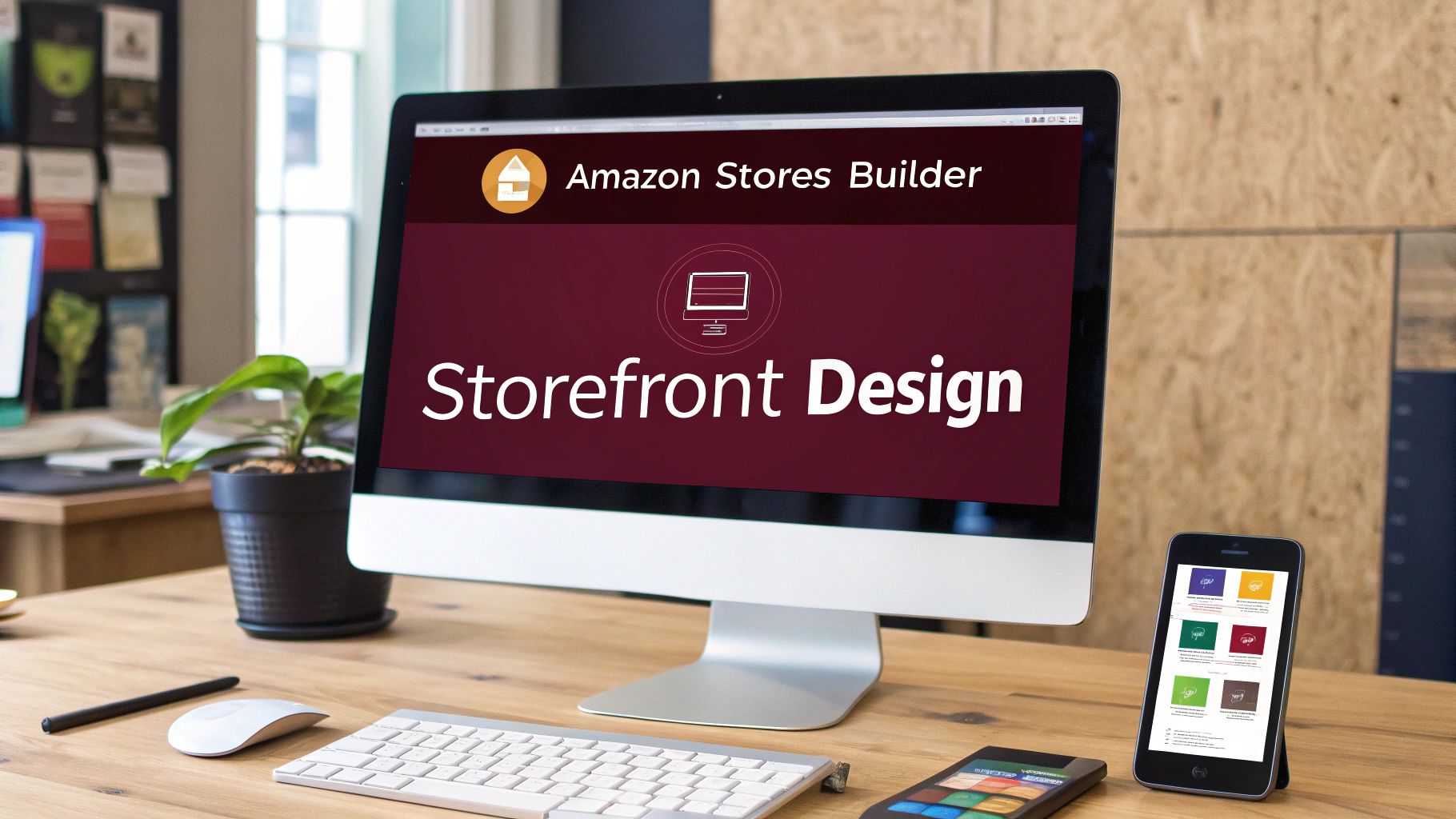
With your Professional account live and Brand Registry approval secured, it’s time for the fun part: building your brand’s home on Amazon. This is where you can create a custom shopping experience that reflects your brand’s personality, and you don’t need to know any code.
Step 1: Access via Campaign Manager
Log in to your Amazon Advertising Console and click on the “Brand Content” tab in the top menu and select “Brand Stores”.
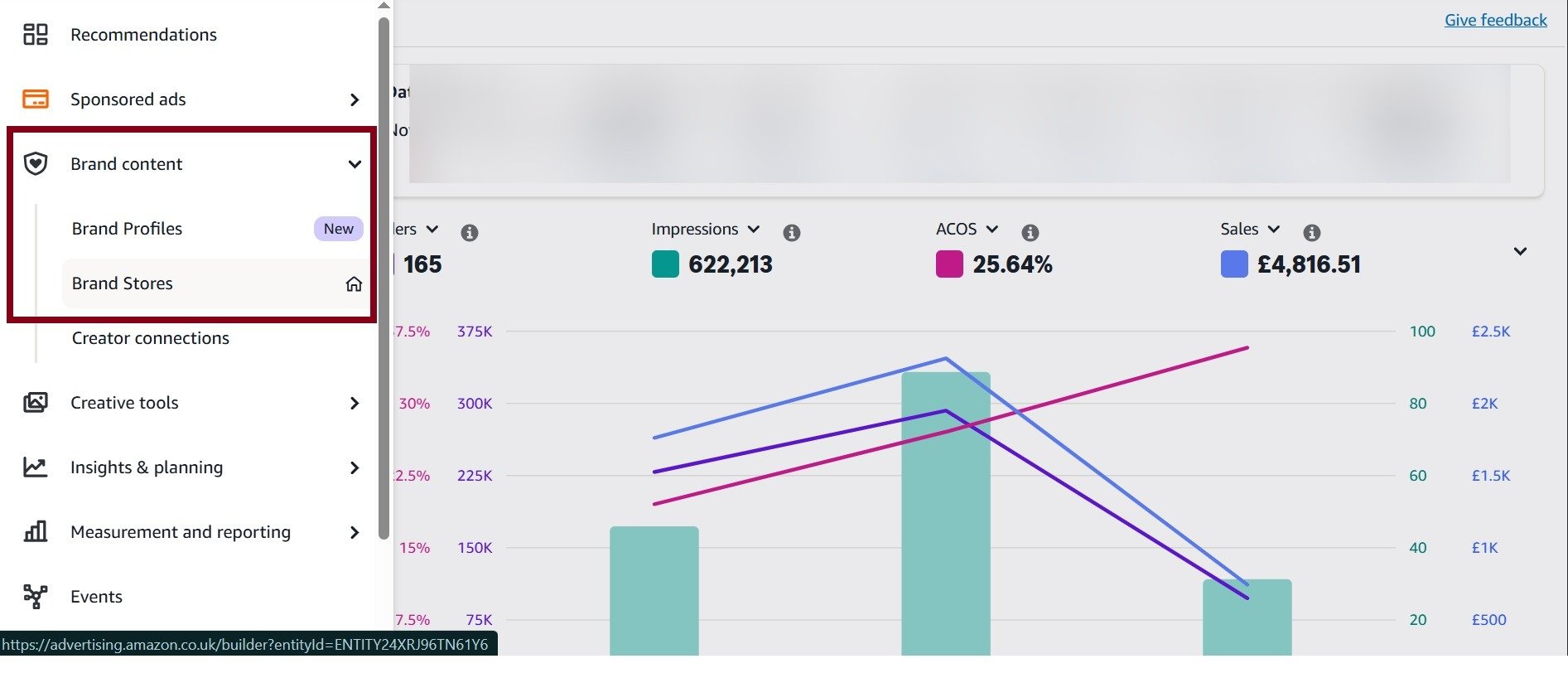
Step 2: Create Brand Store
Select the brand you want to create a store for. If your brand is enrolled in Brand Registry, you’ll see an option to “Create Store.” Click it to open the Store Builder dashboard.
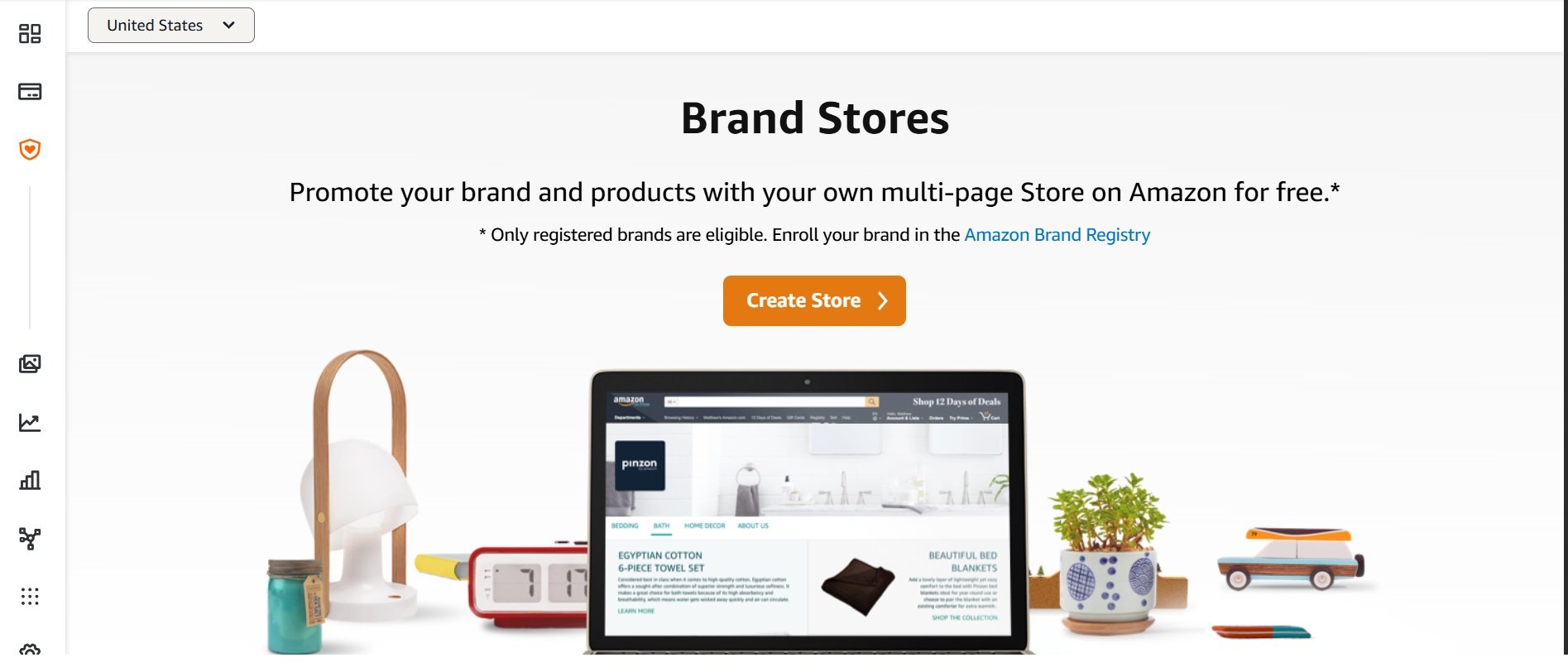
Step 3: Brand Details and Store Preferences
Enter your brand display name and upload your logo. Then choose whether to display deals on your storefront; select “Yes, show” to highlight ongoing promotions or “No, don’t show” to skip them.
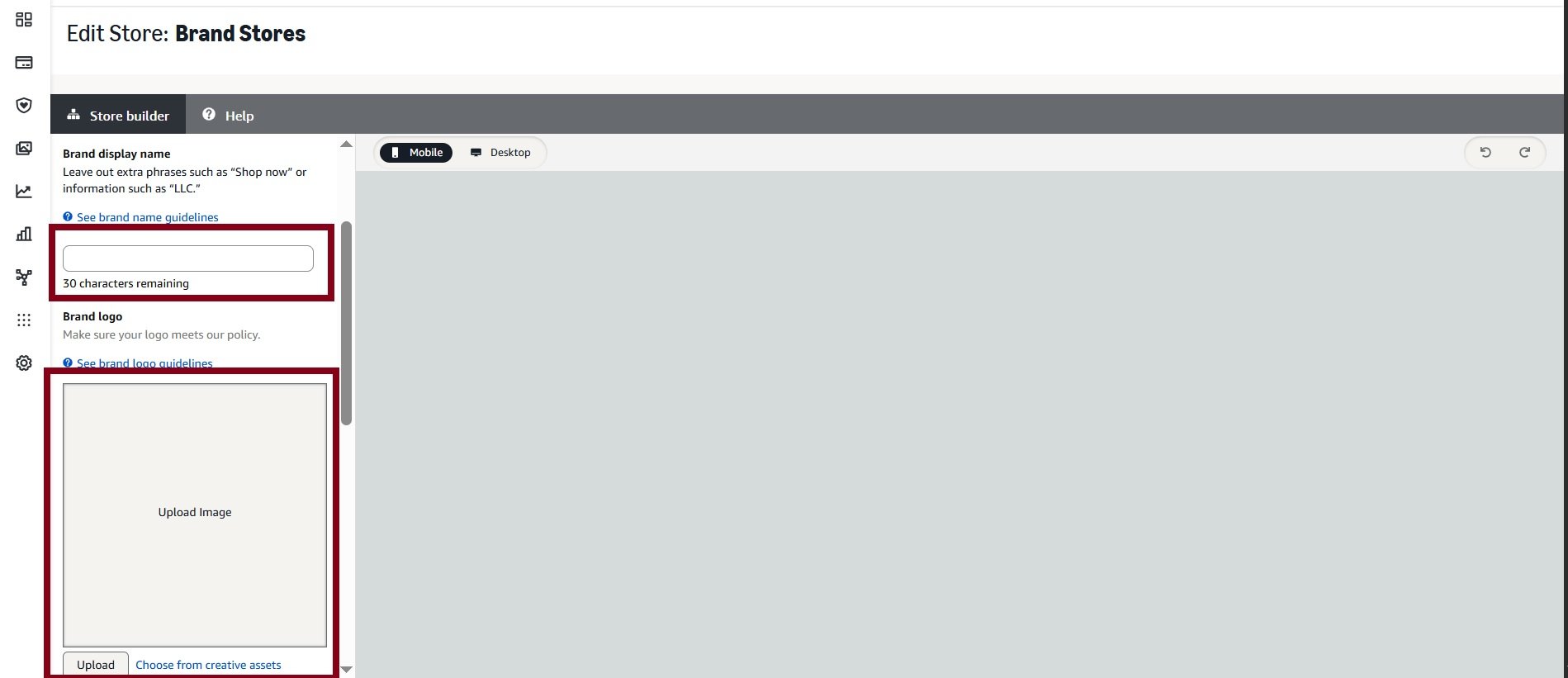
Next, pick your product grid style between Standard or Tall, depending on how you want products to appear. Once done, click Next to move to the Store Builder dashboard.
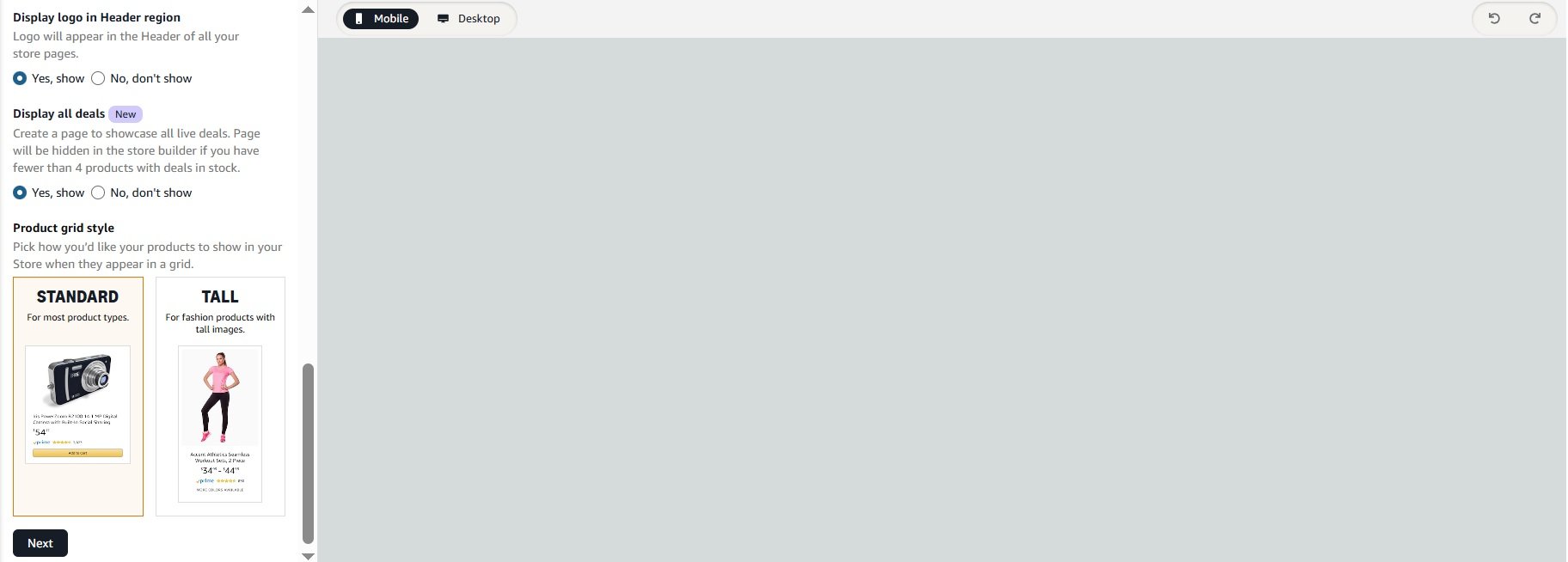
Step 4: Choose the Right Store Template
Amazon provides a few pre-built store templates to get you started. Think of these as a starting point for your homepage design. While you can change almost everything later, picking the right template from the beginning saves a lot of time.

Here’s a quick rundown of your main options:
4.1. Marquee: This template is perfect for brands with a compelling brand story or several product categories. It uses a mix of large, bold images and curated product grids that feel like a high-end digital catalog.
4.2. Showcase: If you’ve invested in great lifestyle photography, this template is your best choice. It’s built to put high-quality images and video front and center, making it ideal for visual-heavy brands in fashion, beauty, or home goods.
4.3. Product Grid: Don’t let the simplicity fool you; this template is all business. It lays out your products in a clean, straightforward grid. It’s the best choice if you want customers to get straight to shopping from your product catalog.
My advice? Don’t overthink it. For smaller catalogs, the Product Grid is a solid, no-fuss choice. If your brand photography is your biggest asset, go with Showcase.
Step 5: Work with the Drag-and-Drop Builder
Once you’ve picked a template, you’ll land in the main Amazon Store builder. The entire system is based on simple drag-and-drop tiles. You don’t need any design experience to create something that looks polished and professional.
The builder has two main parts:
5.1. Page Manager
This is your command center for structuring the entire custom storefront. Here, you can add new pages for things like “Best Sellers,” “New Arrivals,” or specific collections. You’ll also build your store navigation menu and organize your page hierarchy.

Now you can use create pages automatically with AI page builder in seconds. For example select “Create Best seller page” and Amazon will create page with all of your best selling products.
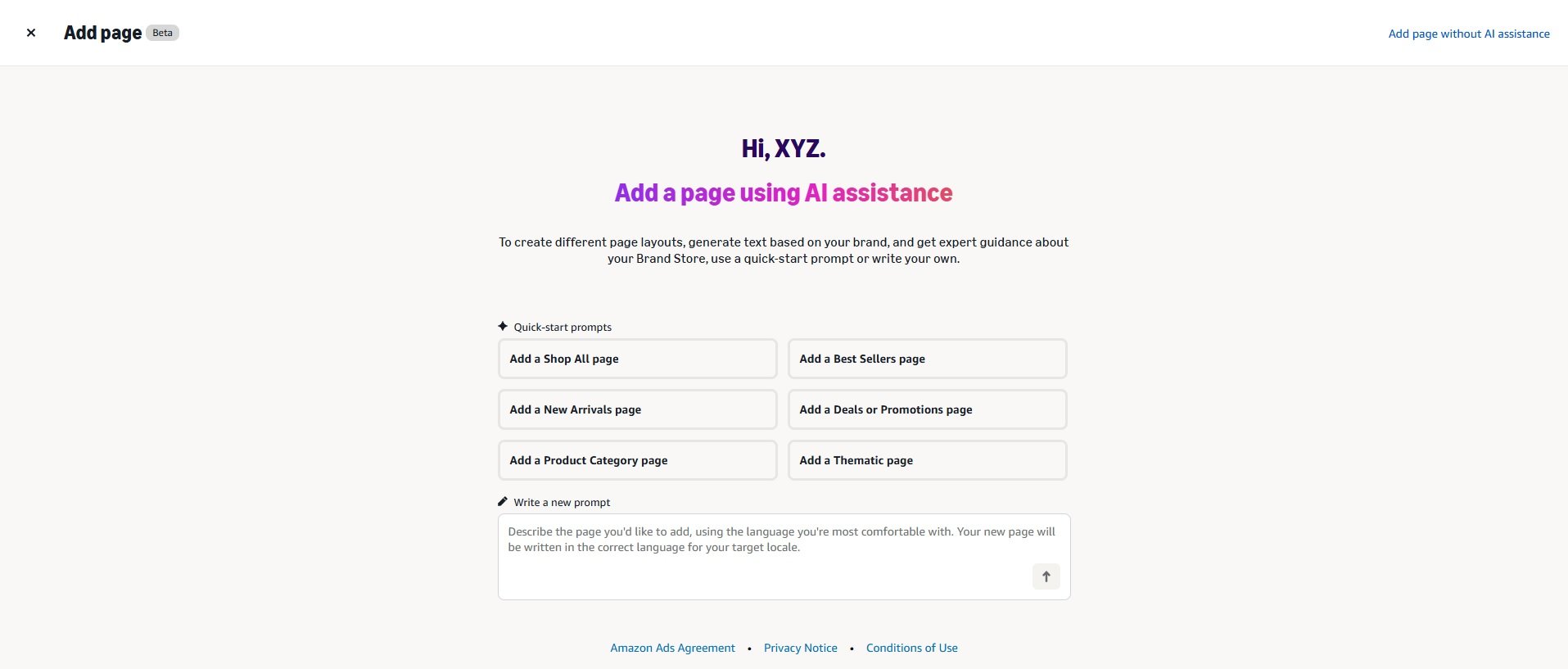
5.2. Tile Manager
This is where you add different content tiles to each page, like an image tile, a product tile, a video, shoppable product image or a text block, to build out the content.

When you’re just starting, build a clean homepage and maybe one or two category pages. You can always add more pages later. Trying to build a massive, 10-page store right away often leads to overwhelm and a messy store layout.
Step 6: Add Rich Media and Visual Content
Your storefront’s success depends on its visual appeal. This is your chance to use high-quality images and videos to tell your brand story and stop shoppers in their tracks.
Good visuals are a powerful sales tool. Data shows that storefronts with fresh visual content and easy navigation see an average sales increase of 25% in their first quarter.
Make sure you’re using a good mix of rich media content to keep things interesting:
6.1. Lifestyle Images: Show your products being used in real-world settings. This helps customers imagine how the product fits into their lives.

6.2. Product Videos: These are great for demonstrating features, explaining benefits, or just giving a 360-degree view.

6.3. Shoppable image: Use this to add clickable points on products and link the relevant ASINs so customers can select a variation and view its listing.
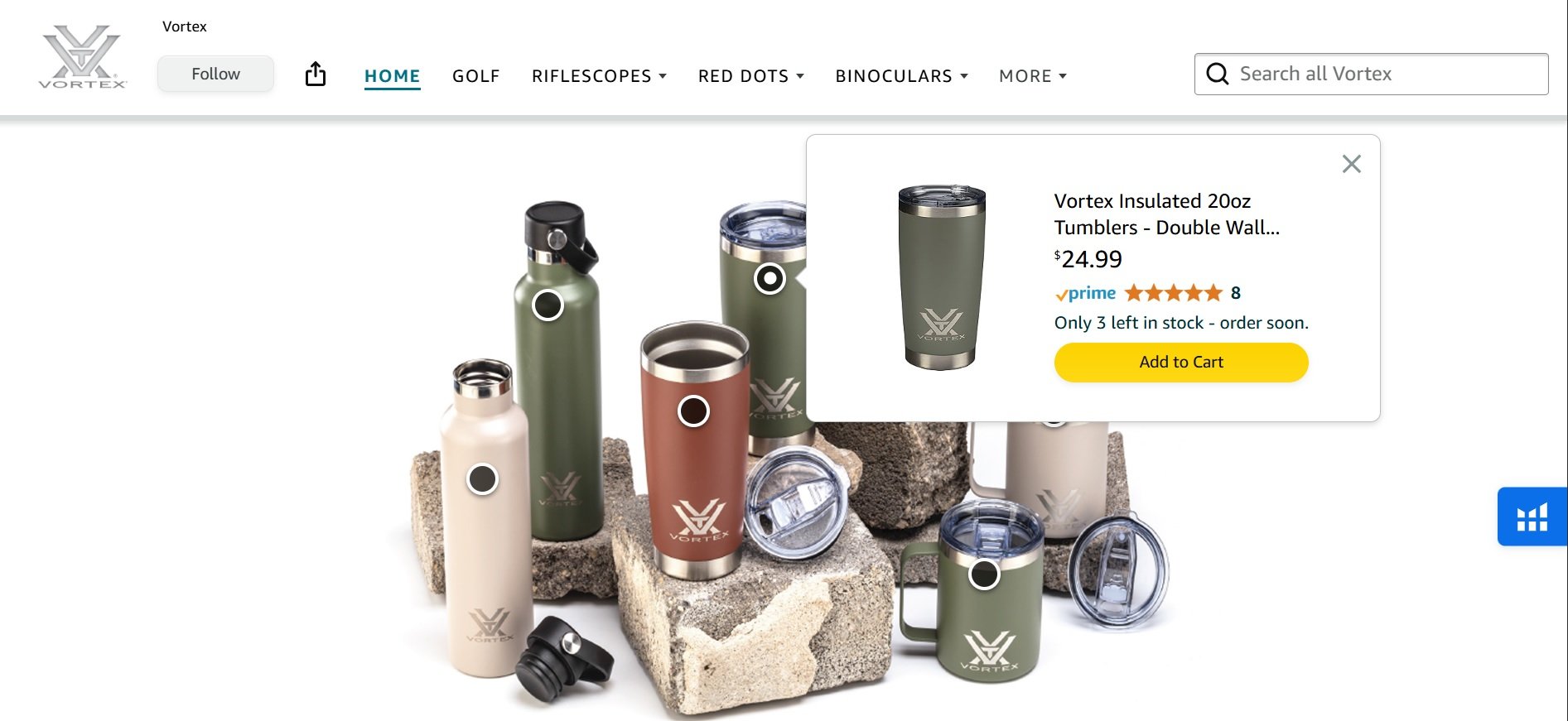
6.4. Infographic Images: Use these to break down key specs or compare different models in a way that’s easy to understand.
Just remember that all your visuals must meet Amazon’s specific requirements. If you’re unsure about file types or dimensions, it’s always smart to double-check the official Amazon image requirements to avoid rejections.
Step 7: Don’t Forget the Mobile-Responsive Design
This is a big one. The majority of Amazon shoppers are browsing and buying on their phones. The Store builder has a handy preview function that lets you switch between desktop and mobile views. Use it often.
A layout that looks amazing on a large desktop screen can quickly become a cluttered mess on a small phone screen. Look for text that’s too small, images that get cropped strangely, or buttons that are hard to tap. A mobile-responsive design isn’t just nice to have; it’s critical for turning traffic into sales.
Step 8: Create Content That Connects and Converts
A slick design will catch a shopper’s eye, but it’s your content that closes the deal. This is where your brand’s personality comes to life, turning a simple product catalog into a shopping destination. Your goal is to make your storefront more than just a list of ASINs; it needs to tell your story and build trust.
Every piece of content you create should have one clear purpose: answer the customer’s questions and show them how your products will improve their life. This is especially true for independent sellers, who now make up more than 60% of total Amazon sales globally. Over the past 25 years, Amazon’s partnership with sellers has generated over $2.5 trillion in sales. That’s the opportunity available for brands that can effectively connect with their audience.
8.1. Weave Your Brand Story
Your storefront’s homepage is prime real estate for telling people who you are. That header image is the first thing they’ll see, so make it count. Use a high-impact lifestyle photo or a clean graphic that instantly communicates your brand’s mission.
But your brand story isn’t just a block of text on an “About Us” page. It’s woven through all of your content:
- Lifestyle Photos: Show your products in real-world settings. This helps customers visualize how they’ll use them. A shot of your hiking backpack on a mountain trail is much more persuasive than a sterile, white-background photo.

- Infographics: Have a product with complex features? Use an infographic to break it down. Showing the different layers of a memory foam mattress in a simple visual is easier for a shopper to understand than a dense paragraph of text.
- Benefit-Focused Copy: Don’t just list features; sell the benefits. Instead of saying “10,000 mAh battery,” say “Power your phone for an entire weekend on a single charge.”
8.2: Showcase Your Products Strategically
One of the biggest advantages of a storefront is curating your product catalog in a way a search results page can’t. Don’t just dump all your products on the homepage. Instead, use product grids and shoppable images to guide the customer’s journey.

Here are a few effective ways to do this:
- Best-Sellers: Put your most popular items front and center on the homepage to build social proof and draw people in.
- New Launches: Create a dedicated page or section to highlight new product launches and generate buzz.
- Themed Collections: Group products by use case or season. A kitchenware brand could create a “Holiday Baking Essentials” collection in November.
Use shoppable image tiles. This feature lets you tag specific products within a single lifestyle photo, creating an interactive and visually rich shopping experience. A customer can see a fully decorated living room, click on the lamp or rug, and go directly to those product detail pages.
8.3. Maintain Brand Consistency
A great storefront feels like a natural extension of your brand’s presence on Amazon. The visual style, tone, and messaging in your store need to align with your A+ Content on individual product pages.
This consistency builds trust and reinforces your brand identity. When someone clicks from your store to a product page and sees the same high-quality imagery and brand voice, it creates a smooth, professional customer journey. This attention to detail is a huge part of Amazon listing optimization, as it ensures every touchpoint strengthens your brand.
Finally, don’t forget about social proof. Weaving in customer testimonials or quotes from positive reviews can be very powerful. Placing a short, impactful quote next to a featured product might be the final push a customer needs to click “Add to Cart.”
Step 9: Submit Your Store for Review
Once you’ve finished building and reviewing your store, click the ‘Submit for Publishing’ button in the top-right corner. Your store will then go through Amazon’s review process and is typically approved within 24 to 72 hours.
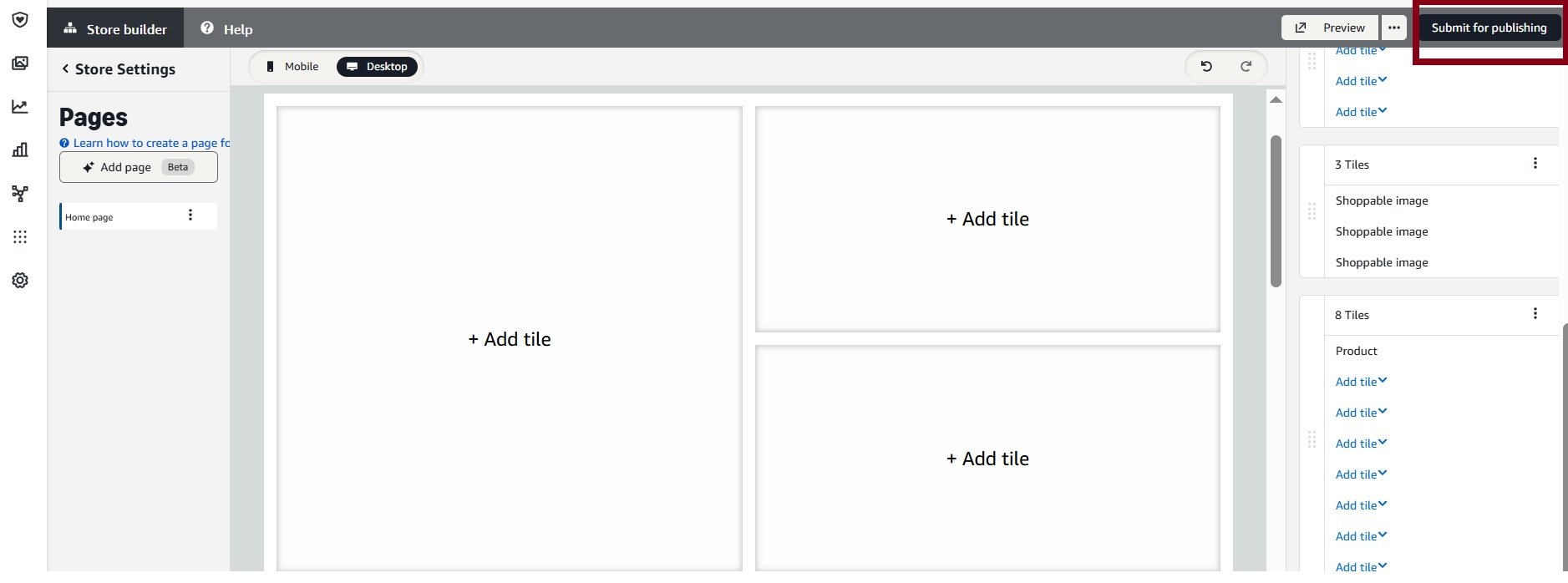
How to Drive Traffic to Amazon Store

A beautiful store with zero visitors won’t help your sales, so your focus has to shift from creation to promotion and analysis. This is how you turn that new store into a sales-driving asset.
Getting shoppers to your storefront requires a two-front approach. You have to pull off-Amazon traffic while also capturing shoppers already on the platform. Nailing this combination will build real brand visibility.
1. Unique Store URL
Every Amazon Storefront comes with its own clean, easy-to-remember store URL, like amazon.com/yourbrand. This is a dedicated landing page you control and should use in all of your off-Amazon marketing.
Here are a few ways this works well:
- Social Media Campaigns: Running an Instagram or TikTok campaign? Direct traffic to your curated storefront for a richer brand experience.
- Email Newsletters: Announcing a new product line? Link them straight to the dedicated page on your store where they can browse the entire collection.
- Influencer Marketing: Give influencers your storefront URL. It’s a clean, professional link that showcases your whole brand.
- QR Codes on Packaging: Add a QR code on your product packaging that leads to your store. This is a great way to encourage repeat purchases and cross-sell other products.
This strategy transforms external traffic into a brand-building opportunity. You’re not just aiming for a one-off purchase; you’re introducing shoppers to your entire brand.
2. On-Amazon Traffic with Sponsored Brands
While external traffic is great, you can’t ignore the millions of shoppers already searching on Amazon. This is where Sponsored Brands advertising campaigns are your best friend. These ads appear at the top of search results and are the perfect tool for funneling internal traffic directly to your storefront.
When a shopper clicks your Sponsored Brands ad, they land on your homepage or a category page, pulling them into your brand’s world, away from competitor products. To understand how your efforts are paying off, mastering marketing analytics is key.
And if you’re looking to improve your campaigns, our guide has some powerful Amazon advertising tips to help you maximize your budget.
3. Use the Store Analytics Dashboard
You can’t improve what you don’t measure. Amazon gives you a dedicated store dashboard for analytics, and learning to read it is crucial for success. You can find it in Seller Central by navigating to Stores > Insights.
This dashboard gives you a clear picture of your store’s performance. You’ll be able to see key performance metrics like:
- Traffic Sources: Where are your visitors coming from? Is it Sponsored Brands campaigns, organic Amazon traffic, or your off-Amazon links? This tells you which channels are working.
- Sales: See the total sales generated from visitors who landed on your store. This helps you calculate your true return on investment.
- Page Views: Discover which pages in your store are the most popular. If your “New Arrivals” page gets a lot of action, you know where to focus your promotional energy.
- Units Sold: Track how many individual products are being sold via your storefront.
Seller Tip: Pay close attention to your traffic sources. If a specific Sponsored Brands campaign is driving a ton of high-converting traffic, that’s a signal to double down on that strategy. If an external campaign isn’t sending visitors, you know it’s time to adjust it or cut it.
Checking these metrics regularly allows you to stop guessing and start making data-driven decisions. You can spot your best-selling products, identify underperforming pages, and refine your ad strategy to ensure every dollar you spend is working to grow your brand.
Common Storefront Mistakes and How to Avoid Them
Building an Amazon Storefront is one of the best steps you can take for your brand, but it’s easy to fall into a few common traps that can hurt your sales. Learning from these frequent mistakes is the quickest way to build a store that performs.
Let’s be honest, we’ve all seen stores that just look off. The navigation is a mess, the images are blurry, and the whole thing feels abandoned. These issues aren’t just cosmetic; they directly impact customer trust and your bottom line.
Here’s a look at the most common pitfalls and, more importantly, how you can avoid them.
1. Forgetting Mobile Shoppers Exist
This is the biggest mistake I see brands make. A huge portion of Amazon’s traffic, your potential customers, are browsing on their phones. If your store isn’t built for mobile, it won’t succeed.
What looks stunning on a large monitor can become a jumbled, unreadable mess on a phone screen. Text gets squished, images are awkwardly cropped, and buttons are impossible to tap. It’s a frustrating experience, and frustrated shoppers don’t buy. They leave.
The Fix: Before you submit your store for review, use the mobile preview feature in the Store builder obsessively. Click through every single page and tile as if you were a customer holding a phone. If anything feels clunky or difficult to navigate, fix it.
2. Using Low-Quality Images and Videos
Your storefront is a direct reflection of your brand. If you use blurry, pixelated, or poorly lit images, you’re communicating a lack of professionalism. This instantly erodes trust and makes shoppers question the quality of your actual products.
This is your chance to look like a premium brand, even if you’re just starting out. Low-resolution visuals make you look amateur, and shoppers will click away to a competitor who looks more credible.
Here’s how to get your visuals right:
- Invest in Good Photography: High-quality product and lifestyle photos are essential. Make sure every image is sharp, well-lit, and looks professional.
- Follow Amazon’s Specs: Always upload your images and videos in the highest resolution Amazon allows. This prevents compression issues that degrade quality.
- Show, Don’t Just Tell: Use lifestyle images and videos to help customers picture your product in their own lives. It’s far more powerful than just a product on a white background.
3. Creating Confusing Navigation
A shopper who can’t find what they’re looking for won’t stick around. A classic mistake is a cluttered navigation menu with too many pages or vague page titles. If a customer has to guess where to click, you’ve already lost them.
Think of your store’s navigation as a clear roadmap. It should be simple and intuitive, guiding visitors to what they want with minimal effort. An overly complex store will increase your bounce rate.
I’ve put together a quick table to help you spot and fix some of the most common issues.
Quick Fixes for Common Storefront Errors
| Common Mistake | Why It’s a Problem | How to Fix It |
|---|---|---|
| Generic Page Titles | Vague names like “Products” or “Gallery” don’t guide shoppers effectively. | Use specific, descriptive titles like “Waterproof Hiking Boots” or “Skincare for Oily Skin.” |
| Too Many Menu Items | A cluttered navigation bar overwhelms visitors and makes it hard to find anything. | Consolidate pages into logical categories. Aim for 3-5 main navigation tabs. |
| No “Shop All” Option | Some customers want to browse everything at once without clicking through categories. | Always include a “Shop All” or “View All Products” page for easy browsing. |
| Unlinked Banners | A beautiful banner image that doesn’t lead anywhere is a dead end for the customer. | Ensure every shoppable image, banner, and tile links to the correct product or category page. |
Treat this table as your pre-launch checklist. Running through these points can help you catch simple errors that have a big impact on the customer experience.
4. Letting Your Store Go Stale
Treat your storefront like a living part of your business, not a “set it and forget it” project. A store still showing last year’s holiday promotions or featuring out-of-stock products tells shoppers that no one is managing the store. It hurts your brand’s credibility.
Beyond updating content, it’s critical to keep up with Amazon’s rules. It’s smart for any seller to understand how to stay compliant with Amazon’s changing policies. Non-compliance can lead to serious headaches, so staying informed is crucial for keeping your account healthy.
If you want to understand the serious consequences of policy violations, it’s worth reading about what happens when an Amazon account is suspended.
Your Top Amazon Storefront Questions, Answered
If you’re thinking about building a custom brand space on Amazon, you probably have a few questions. Let’s get right to it and tackle the most common things sellers ask when they’re ready to create their first Store.
How Much Does an Amazon Storefront Actually Cost?
The short answer? Building the Store itself is completely free. Amazon doesn’t charge you to use their Stores builder tool.
However, you can’t get started without a couple of things that do have costs.
- A Professional Seller Account: To access the Stores builder, you need to be on the Professional selling plan. This comes with a monthly subscription fee (currently $39.99 in the U.S.). The basic Individual seller plan won’t work.
- A Registered Trademark: This is the big one. Creating a Store is a benefit for brand-registered sellers, and you can’t get into Brand Registry without a trademark. The cost for this can vary widely, from a few hundred to a couple of thousand dollars. It depends on which trademark office you’re using (like the USPTO) and whether you use a program like Amazon’s IP Accelerator.
So, while the tool is free, think of these as the required tickets to get into the show.
How Long Is the Wait for Amazon to Approve My Store?
Once you’ve put the finishing touches on your Store and hit the submit button, the waiting begins. Typically, Amazon’s review team gets back to you within 24 to 72 hours.
Keep in mind, that timeline isn’t set in stone.
During busy times, like the Q4 holiday rush, everyone is trying to get their updates published, and review times can be longer. Amazon’s team manually checks everything to make sure it meets their creative guidelines. They’re looking for typos, blurry images, or anything that violates their policies.
My Pro Tip: Don’t give them a reason to say no. Before you submit, do a final sweep for spelling errors and double-check that every image and video is high-quality and meets Amazon’s specs. A rejection means you go back to the editor, fix the problem, and get back in the review queue, starting the clock all over again.
Can I Get Around the Trademark Requirement?
Nope. This one is a firm requirement. A registered trademark is your golden ticket to unlocking Amazon Brand Registry, and Brand Registry is the only way to get access to the Stores builder.
There are no shortcuts here. If you aren’t brand registered, you can’t get an Amazon store. If a trademark isn’t on your radar yet, that needs to become your top priority.
Here’s the breakdown based on where you are in the process:
- If you have a pending trademark application: You’re in luck. Amazon’s IP Accelerator program can be a great help. By using one of their pre-approved law firms to file, Amazon often grants you access to Brand Registry and its tools (including Stores) while your trademark is still pending. This can save you months of waiting.
- If you haven’t started the trademark process: This is your first move. You simply can’t build a Store until you have, at minimum, a pending application filed with the appropriate trademark office.
Bottom line: your path to a great Amazon Storefront starts with protecting your brand.





